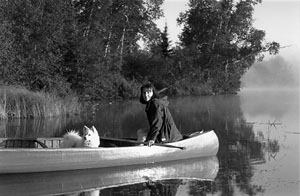Graduate Students:
Natalie Tashe MSc Graduate, 1998
Natalie (Tasha) Tashe completed her B.Sc. in Geography from the University of Winnipeg in 1995 and graduated in 1996. Tasha has taken courses at the University of British Columbia in 1996 in order to meet the course requirements for the Professional Agrologist status of the British Columbia Institute of Agrologists. She completed her M.Sc. in Geography (forest ecology & soils) at Simon Fraser University in 1998 and graduated in June, 1999. She currently works as as a Research Assistant at University of Alberta and is a member of a number of soil science organizations.
Summary of Research:
The impact of vine maple on site fertility of coastal forests in Southwestern British Columbia
Vine maple (Acer circinatum, Pursh), is a common understory tree species of Pacific Northwest coastal forests (see site map) which has received very little attention for its role in biogeochemical nutrient cycling. Vine maple was studied to determine if it enhanced site fertility and if it was beneficial to the nutrient status of adjacent Douglas-fir (Pseudotsuga menziesii Franco). Site fertility was assessed by analyzing litterfall, forest floor, mineral soil and Douglas-fir foliage using plots where vine maple was present or absent. Twenty-seven paired plots were selected in southwestern British Columbia. Fifteen paired plots were established in two 75 year-old stands at Seymour Demonstration Forest (SDF), and twelve were chosen in a 130 year-old stand at UBC Research Forest (UBCRF).
Total autumn litterfall collected from vine maple plots had significantly higher nitrogen (N) than litterfall from conifer plots, which translated into slightly higher mineralizable N in the forest floor, and significantly greater N availability in the upper mineral soil. Nitrogen concentration in Douglas-fir foliage was slightly higher for vine maple plots as compared to conifer plots, and Douglas-fir surrounding vine maple had fewer signs of N deficiency.
Relative to conifer litterfall, vine maple litter had greater base and boron (B) concentrations and contents. The higher litter quality resulted in forest floors and upper mineral soils under vine maple that were richer in total and exchangeable calcium, magnesium and potassium concentrations. At SDF, the presence of vine maple appeared to alleviate B deficiency for adjacent Douglas-firs. Phosphorus (P) deficiency was slightly reduced for Douglas-fir surrounding vine maple at SDF, although total and available P showed no consistent pattern in the forest floor and mineral soil at either study location.
Mull humus forms dominated vine maple plots, while mor humus forms dominated conifer plots at UBCRF. Mull characteristics were reflected in the forest floor and mineral soil properties. Lower total carbon (C) amounts occurred in the forest floor, and a thicker Ah layer in the upper 7 cm of the mineral soil contained greater C concentration and content for vine maple plots, indicating faster nutrient cycling relative to conifer plots at both study locations.
The presence of vine maple may be desirable in coastal forests of southwestern B.C., not only because it adds to the structural and species diversity, but due to its contributions to nutrient cycling, improvement of the nutrient status of adjacent Douglas-fir and its potential for improving long-term sustainability.
PUBLICATIONS:
Tashe, N.C. and Schmidt, M.G. 2003. The influence of understory vine maple on forest floor and mineral soil properties in coastal temperate forests. Canadian Journal of Soil Science. 83: 35-44.
Tashe, N.C. and Schmidt, M.G. 2001. The impact of vine maple on site fertility of coastal temperate forests. Forest Ecology and Management. 147: 263-279.
Tashe, N.C. 1998. The impact of vine maple on the biogeochemical nutrient cycle of conifer-dominated coastal forests in southwestern B.C. M.Sc. thesis. Simon Fraser University, Burnaby, B.C.
